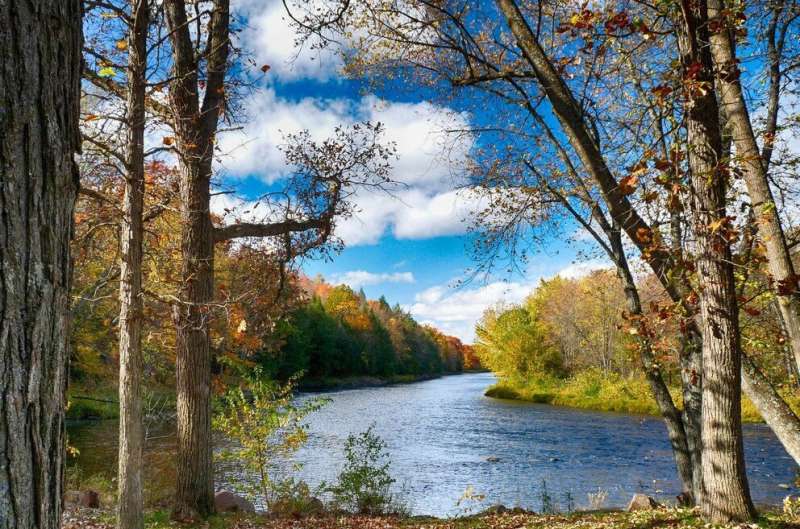Despite the devastating impact of the invasive emerald ash borer on forests in the eastern and midwestern parts of the United States, climate change will have a much larger and widespread impact on these landscapes by the year 2100, according to researchers. Credit: Pixabay
The emerald ash borer, an invasive beetle native to Southeast Asia, threatens the entire ash tree population in North America and has already changed forested landscapes and caused tens of billions of dollars in lost revenue to the ash sawtimber industry since it arrived in the United States in the 1990s. Despite the devastating impact the beetle has had on forests in the eastern and midwestern parts of the U.S., climate change will have a much larger and widespread impact on these landscapes through the end of the century, according to researchers.
"We really wanted to focus on isolating the impact of the emerald ash borer on biodiversity, forest composition, biomass and other factors," said Stacey Olson, program coordinator and legal assistant at Resources Legacy Fund. Olson completed the research as part of her master's thesis at Penn State. "We found that emerald ash borer and its impact on ash trees has serious implications for forest change at the site level, but at the broad landscape level, the climatic changes over the next century were much more important in terms of forest composition and species diversity."
The researchers used a forest simulation model to examine the effects of the emerald ash borer and climate change on a forested area of northeast Wisconsin through the year 2100. The area includes the Menominee Reservation. The Menominee Indian Tribe of Wisconsin has been sustainably harvesting timber from the forest for more than 150 years. The scientists reported their findings in the journal Ecosystems.
The model took into account how trees grow, disperse seeds, die and interact with disturbances such as climatic changes. It also accounted for emerald ash borer infestation and pre-emptive ash tree removal, an Indigenous forest management strategy.
"When we run the model, all of these components work simultaneously and interact with one another across the landscape and across time," said Olson, who was also an Environmental Scholar in the Earth and Environmental Systems Institute (EESI) at Penn State. "The model gives us a picture of what all these interacting disturbance and succession processes look like."
The researchers looked at moderate and high-level climate change scenarios based on a business-as-usual approach that fails to curb greenhouse gas emissions within the next decade. The landscape itself partly drove the team's decision to study these scenarios, Olson said. The forest sits in what scientists call a tension zone, where vegetation, soil type and climate variability can shift quickly as one moves across the landscape. In these areas, changes in climate can result in drastic changes on the ground.
The model showed a shift in the types of trees present in the study area by 2100. Northern hardwoods, like beech and birch trees, decreased by approximately 12%, to 35% of the total biomass of all species in the forest. Under climate change conditions, southern hardwoods, like black cherry trees, increased from 4% to 23% by mid-century and became the dominant species in the southern part of the study area.
The model showed that in some areas, the emerald ash borer would completely remove ash trees, clearing the way for other species to replace them. Ash, however, is not the dominant species in the forest, and its removal cannot account for the large shift in tree composition from northern to southern hardwoods. The researchers attributed this shift to climatic changes, such as warmer temperatures and periods of drought or water scarcity, identified in the models.
The study led by Olson is part of a larger project, Visualizing Forest Futures (ViFF), led by Erica Smithwick, distinguished professor of geography and EESI associate, and done in collaboration with the Menominee. The project combines Indigenous forest-management practices with cutting-edge modeling and visualization techniques to better understand the connections between human values and forests and how to sustainably manage forest resources.
"Our project seeks to guide decision-making about forest management strategies while also accounting for uncertainties in forest changes under future climates," Smithwick said. "Stacey's paper provides key information to help guide that process."
The team's research demonstrates the importance of focusing more resources on climate change mitigation rather than on a very specific, targeted threat like the emerald ash borer.
"Some of the research I found said that the ash will likely become functionally extinct within the next couple of decades," said Olson. "While this is clearly a serious problem that deserves attention, a big takeaway for me is that climate is an even larger driver of forest change over the next century, and addressing these challenges must be a top priority."
More information: Stacey K. Olson et al, Landscape-Scale Forest Reorganization Following Insect Invasion and Harvest Under Future Climate Change Scenarios, Ecosystems (2021). DOI: 10.1007/s10021-021-00616-w
Journal information: Ecosystems
Provided by Pennsylvania State University
























